The Historical Transformation of Peri-Urban Land Use Patterns, via Landscape GIS-Based Analysis and Landscape Metrics, in the Vesuvius Area
Abstract
:1. Introduction
- a better understanding of the current state (land composition and conformation) of land systems;
- the identification of the dynamics of and driving forces behind complex systems in a territorial context;
- the monitoring of these dynamics;
- the evaluation of adopted strategies and policies;
- the construction of future scenarios and the assessment of their possible environmental and socio-economic impacts;
- the support of the land management and planning, according to sustainability principles.
2. Materials and Methods
2.1. The Study Area
2.2. Land Use/Cover Change Analysis
2.2.1. Historical Maps Acquisition and Recent Dataset Analysis
- 1817—Topographic and hydrographic map of the contours of Naples (Topographical Office of the Naples Kingdom)—1:250,000. The accuracy of the map and its history was reported by Pindozzi et al. (2016)
- 1907—Topographic map of Italy series 25v (Military Geographic Institute)—1:25,000
- 1960—Land use map of Italy (National Research Council and Italian Touring Club)—1:200,000
- 2009—Campania region agricultural land uses map (Agricultural Division of the Campania Region)—1:50,000
- 1817—Topographic and hydrographic map of the contours of Naples (Topographical Office of the Naples Kingdom)
- 1907—Topographic map of Italy series 25v (Military Geographic Institute)
- 1960—Land use map of Italy (National Research Council and Italian Touring Club)
- 2009—Campania Region Agricultural land uses Map
2.2.2. GIS Processing
- the land use map of 1817 within the urban boundaries of the 1907 map;
- the land use map of 1907 within the urban boundaries of the 1960 map;
- the land use map of 1960 within the urban boundaries of the 2009 map;
2.3. Landscape Analysis
- Aggregation metrics. These metrics refer to the tendency of patch types to be spatially aggregated by means of the clustering of patches to form patches of a large size. This property is also usually used as an umbrella term to describe several closely related concepts of dispersion and interspersion, subdivision and isolation. Thanks to the aggregation process, it is usually possible to recognize the reduction in the number of total patches (PN metric, the simplest measure of subdivision; at the class level used to measure the fragmentation index), the increase of their mean areas (AREA_MN) and of their joint interpretation, i.e., the proportion of landscape occupied by the patch type (PLAND).
- Compaction metrics. These metrics mainly refer to landscape configuration, quantifying the geometric tendency of patches of the same type to assume a circular shape (the most compact). The inverse process is elongation. Among these metrics, the shape index (SHAPE_MN) measures the complexity of patch shape compared to a standard shape (square) of the same size. Further information is also obtained from metrics which analyse the composition of the landscape, such as the radius of gyration (GYRATE_MN). Specifically, this metric describes how far across the landscape a patch extends its reach. Thanks to the compaction process, it is possible to recognize a decrease in the SHAPE_MN metric and an increase in the GYRATE_MN one.
- Dispersion/isolation metrics. These metrics refer to the tendency of the distances between patches of the same type to increase. Dispersion metrics refer to the spatial distribution of a patch type (class). Euclidean nearest neighbour distance (ENN) is defined using simple Euclidean geometry as the shortest straight-line distance between the focal patch and its nearest neighbour of the same class, based on the mean distance between the two closest cell centres of the same type (ENN_MN). This metric measures the loss of structural connectivity without considering the characteristics of other land use/cover classes or the presence of barriers (and how they increase or decrease the cost of movement for different species). Thanks to the possible dispersion process, it is usually possible to recognize increases in ENN_MN. Specifically, for urban class type analysis, a greater isolation is considered as a sign of greater dispersion, i.e., a decreasing distance between urban patches is, in fact, an index of urban sprawl.
2.4. Land Use Maps Comparison and Changes Detection
- The rows report the land uses, expressed in hectares, of the first map;
- The columns report the land uses, expressed in hectares, of the first map.
- The diagonal of the table reports the hectares of each category that have not undergone any changes during the time step considered;
3. Results
3.1. Land Use-Cover Maps Analysis and GIS Processing
- Four LU maps of the whole study-area, with a common reclassified legend (Figure 5).
- Four LU maps, three of them devoted to each time step considered (1817, 1907, 1960) and clipped on the urban class recognizable in the subsequent time step (1907, 1960, 2009, respectively); a fourth land use map was clipped with the buffer areas of 100 m around the urban areas of the 2009 map (Figure 6).
- the LU map of 1817 is characterized by the dominant presence of forests;
- the LU map of 1907 is characterized by the rapid and constant growth of vineyards and sparse vegetation;
- the LU map of 1960 is characterized by an initial reduction in vineyards;
- finally, the LU map of 2009, is characterized by significant anthropogenic pressure and urban sprawl and the almost total disappearance of vineyards.
3.2. Landscape Metrics Analysis
3.3. Land Use Changes Comparison
- urban areas, which have increased by almost 700% principally at the expense of agricultural areas, vineyards and, moderately, forests.
- sparse vegetation areas, which have increased up to 1800%, mainly producing a reduction in forests, but also in vineyards and agricultural areas.
- vineyards, which have experienced a decrease of 99%, nearly disappearing from the Vesuvius area; it is interesting to note that vineyards have completely disappeared the original areas of the 2009 LU map, while a few hectares were still detectable in areas occupied by forests in the past.
- a significant increase in sparse vegetation areas, over 1700%, almost exclusively at the expense of forest areas.
- a significant increase in vineyards, equal to nearly 200%, due to changes in land use from other categories of agricultural areas.
- the main variation concerns urban areas, which have increased by 330%, subtracting land from agricultural areas and vineyards.
- vineyards have almost completely disappeared (−99.5%); the few hectares still existing are obtained from areas previously affected by forests and sparse vegetation.
- Higher KLoc values in the nineteenth century (the comparison of the 1817 and 1907 maps) show that most categories are in identical positions in both maps.
- Higher KHisto values in the last half century (the comparison of the 1960 and 2009 maps) show a fair permanence, with the amounts total hectares belonging to the various LU types remaining constant when not considering whether there has been a change in spatial location. This statistic is supported and confirmed by the data reported in Table 8, in which it is possible to recognize the lowest differences in area variation (with the exception of urban areas and vineyards, which offset each other) compared to the other periods considered.
- The fraction correct statistic, which calculates the number of equal cells divided by the total number of cells, shows that the most significant land use transformations occurred between 1817 and 1907.
- a comparison between 2009 and 1960, in order to analyse the development of trends in the last fifty years;
- a comparison between 2009 and 1817, in order to analyse all of the changes affecting the land surrounding urban areas in the last two centuries.
4. Discussion
- the forests that used to make up 32% of the territory currently occupy 20% of it;
- agricultural areas and vineyards previously made up 43% and 21% of the territory, respectively, whereas now they make up 36% of it;
- sparse vegetation areas went from 1% to 20% in 2009;
- urban areas increased from 3% to 24%.
5. Conclusions
Author Contributions
Funding
Institutional Review Board Statement
Informed Consent Statement
Conflicts of Interest
References
- Salvati, L. Agro-forest landscape and the ‘fringe’ city: A multivariate assessment of land-use changes in a sprawling region and implications for planning. Sci. Total Environ. 2014, 490, 715–723. [Google Scholar] [CrossRef] [PubMed]
- Terbeck, F.J. Defining Suburbs: An Evaluation and Comparison of Four Methods. Prof. Geogr. 2020, 72, 586–597. [Google Scholar] [CrossRef]
- Simon, D. Urban environments: Issues on the peri-urban fringe. Ann. Rev. Env. Resour. 2008, 33, 167–185. [Google Scholar] [CrossRef]
- Agarwal, C. A Review and Assessment of Land-Use Change Models: Dynamics of Space, Time, and Human Choice; UFS Technical Report NE-297; U.S. Department of Agriculture Forest Service, Northeastern Forest Research Station: Burlington, VT, USA, 2002. Available online: http://www.fs.fed.us/ne/newtown_square/publications/technical_reports/pdfs/2002/gtrne297.pdf (accessed on 10 May 2021).
- Murray-Rust, D.; Robinson, D.T.; Guillem, E.; Karali, E.; Rounsevell, M. An open framework for agent based modelling of agricultural land use change. Environ. Model. Softw. 2014, 61, 19–38. [Google Scholar] [CrossRef]
- Zhang, L.; Nan, Z.; Yu, W.; Ge, Y. Modeling Land-Use and Land-Cover Change and Hydrological Responses under Consistent Climate Change Scenarios in the Heihe River Basin, China. Water Resour. Manag. 2015, 29, 4701–4717. [Google Scholar] [CrossRef]
- Pindozzi, S.; Cervelli, E.; Recchi, P.F.; Capolupo, A.; Boccia, L. Predicting land use change on a broad area: Dyna-CLUE model application to the Litorale Domizio-Agro Aversano (Campania, South Italy). J. Agric. Eng. 2017, 48, 27. [Google Scholar] [CrossRef]
- Cervelli, E.; di Perta, E.S.; Pindozzi, S. Energy crops in marginal areas: Scenario-based assessment through ecosystem services, as support to sustainable development. Ecol. Indic. 2020, 113, 106180. [Google Scholar] [CrossRef]
- Pindozzi, S.; Cervelli, E.; Capolupo, A.; Okello, C.; Boccia, L. Using historical maps to analyze two hundred years of land cover changes: Case study of Sorrento peninsula (south Italy). Cartogr. Geogr. Inf. Sci. 2015, 43, 250–265. [Google Scholar] [CrossRef]
- Uuemaa, E.; Antrop, M.; Roosaare, J.; Marja, R.; Mander, U. Landscape Metrics and Indices: An Overview of Their Use in Landscape Research. Liv. Rev. Landsc. Res. 2009, 3, 1–28. [Google Scholar] [CrossRef]
- Frank, S.; Fürst, C.; Koschke, L.; Makeschin, F. A contribution towards a transfer of the ecosystem service concept to land-scape planning using landscape metrics. Ecol. Indic. 2012, 21, 30–38. [Google Scholar] [CrossRef]
- Gustafson, E.J. Minireview: Quantifying Landscape Spatial Pattern: What Is the State of the Art? Ecosystems 1998, 1, 143–156. [Google Scholar] [CrossRef]
- McGarigal, K. Landscape pattern metrics. In Encyclopedia of Environmetrics; El-Shaarawi, A.H., Piegorsch, W.W., Eds.; John Wiley & Sons: Chichester, UK, 2002; pp. 1135–1142. [Google Scholar]
- McGarigal, K. Fragstats Help. Amherst: Department of Environmental Conservation University of Massachusetts. 2015. Available online: https://www.umass.edu/landeco/research/fragstats/documents/fragstats.help.4.2.pdf (accessed on 10 May 2021).
- Geoghegan, J.; Wainger, L.; Bockstael, N.E. Spatial landscape indices in a hedonic framework: An ecological economics analysis using GIS. Ecol. Econ. 1997, 23, 251–264. [Google Scholar] [CrossRef]
- Alberti, M.; Marzluff, J.M. Ecological resilience in urban ecosystems: Linking urban patterns to human and ecological functions. Urban. Ecosyst. 2004, 7, 241–265. [Google Scholar] [CrossRef]
- Liu, M.; Hu, Y.-M.; Li, C. Landscape metrics for three-dimensional urban building pattern recognition. Appl. Geogr. 2017, 87, 66–72. [Google Scholar] [CrossRef]
- Madanian, M.; Soffianian, A.R.; Koupai, S.S.; Pourmanafi, S.; Momeni, M. Analyzing the effects of urban expansion on land surface temperature patterns by landscape metrics: A case study of Isfahan city, Iran. Environ. Monit. Assess. 2018, 190, 189. [Google Scholar] [CrossRef]
- Cervelli, E.; Scotto Di Perta, E.; Di Martino, A.; Faugno, S.; Pindozzi, S. Historical land use change and landscape pattern evolution study. In Environmental and Territorial Modelling for Planning and Design; Smart City, Urban Planning for a Sustainable Future; Leone, A., Gargiulo, C., Eds.; FedOAPress: Napoli, Italy, 2018; Volume 4, pp. 189–197. [Google Scholar]
- Vesuvian Observatory. The Eruptions from 1631 to 1944. Available online: www.ov.ingv.it/ov/it/catalogo-1631-1944.html (accessed on 12 July 2021).
- Vianello, G.; Antisari, L.V. Pedo-environmental evolution and agricultural landscape transformation. Ital. J. Agron. 2009, 4, 5–12. [Google Scholar] [CrossRef] [Green Version]
- Pelorosso, R.; Leone, A.; Boccia, L. Land cover and land use change in the Italian central Apennines: A comparison of as-sessment methods. Appl. Geogr. 2009, 29, 35–48. [Google Scholar] [CrossRef]
- Brovelli, M.A.; Minghini, M. Georeferencing old maps: A polynomial-based approach for Como historical cadastres. e-Perimetron 2012, 7, 97–110. [Google Scholar]
- Mori, A. Le Carte Geografiche. Costruzione Interpretazione e Applicazioni Pratiche [The Maps. Construction Inter-Pretation and Practical Applications]; Libreria Goliardica: Pisa, Italy, 1989. (In Italian) [Google Scholar]
- Petit, C.; Scudder, T.; Lambin, E. Quantifying processes of land-cover change by remote sensing: Resettlement and rapid land-cover changes in south-eastern Zambia. Int. J. Remote Sens. 2001, 22, 3435–3456. [Google Scholar] [CrossRef]
- Rhemtulla, J.M.; Mladenoff, D.J.; Clayton, M.K. Regional land-cover conversion in the U.S. upper Midwest: Magnitude of change and limited recovery (1850–1935–1993). Landsc. Ecol. 2007, 22, 57–75. [Google Scholar] [CrossRef]
- Wan, L.; Zhang, Y.; Zhang, X.; Qi, S.; Na, X. Comparison of land use/land cover change and landscape patterns in Honghe National Nature Reserve and the surrounding Jiansanjiang Region, China. Ecol. Indic. 2015, 51, 205–214. [Google Scholar] [CrossRef]
- Ferreira, H.; Botequilha-Leitão, A. Integrating landscape and water resources planning with focus on sustainability. In From Landscape Research to Landscape Planning. Aspects of Integration, Education and Application; Tress, B., Tress, G., Fry, G., Opdam, P., Eds.; Springer: Dordrecht, The Netherlands, 2005; pp. 143–159. [Google Scholar]
- Frank, S.; Fürst, C.; Lorz, C.; Koschke, L.; Abiy, M.; Makeschin, F. Chances and limits of using landscape metrics within the interactive planning tool “Pimp Your Landscape”. In Proceedings of the Land Mod 2010, Montpellier, France, 3–10 February 2010; p. 13. [Google Scholar]
- Uuemaa, E.; Mander, Ü.; Marja, R. Trends in the use of landscape spatial metrics as landscape indicators: A review. Ecol. Indic. 2013, 28, 100–106. [Google Scholar] [CrossRef]
- Dematteis, G. Suburbanización y periurbanización. Ciudades anglosajonas y ciudades Latinas, English cities and Latin cit-ies. In La Ciudad Dispersa. Suburbanización y Periferias, The Dispersed City. Suburbanization and Outlying Areas; Monclús, J., Ed.; Centre de Cultura Contemporánea de Barcelona: Barcelona, Spain, 1998; pp. 17–33. [Google Scholar]
- Franco, D.; Bombonato, A.; Mannino, I.; Ghetti, P.; Zanetto, G. The evaluation of a planning tool through the landscape ecology concepts and methods. Manag. Environ. Qual. Int. J. 2005, 16, 55–70. [Google Scholar] [CrossRef] [Green Version]
- Dematteis, G.; Governa, F. Urban form and governance: The new multi-centred urban patterns. In Change and Stability in Urban Europe; Andersson, H., Jorgensen, G., Joye, D., Ostendorf, O., Eds.; Routledge: London, UK, 2017; pp. 27–44. [Google Scholar]
- Aguilera-Benavente, F.; Valenzuela, L.M.; Botequilha-Leitao, A. Landscape metrics in the analysis of urban land use patterns: A case study in a Spanish metropolitan area. Landsc. Urban Plan. 2011, 99, 226–238. [Google Scholar] [CrossRef]
- Nong, D.H.; Lepczyk, C.A.; Miura, T.; Fox, J.M. Quantifying urban growth patterns in Hanoi using landscape expansion modes and time series spatial metrics. PLoS ONE 2018, 13, e0196940. [Google Scholar] [CrossRef] [Green Version]
- McGarigal, K.; Cushman, S.A.; Ene, E. FRAGSTATS v4: Spatial Pattern Analysis Program for Categorical and Continuous Maps. University of Massachusetts, Amherst. Computer Software Program Produced by the Authors at the University of Massachusetts. 2012. Available online: https://www.umass.edu/landeco/research/fragstats/fragstats.html (accessed on 15 July 2021).
- Map Comparison Kit Software. Available online: http://mck.riks.nl/ (accessed on 10 May 2021).
- Visser, H.; De Nijs, T. The map comparison kit. Environ. Modell. Softw. 2006, 21, 346–358. [Google Scholar] [CrossRef]
- Pontius, R.G., Jr. Comparison of categorical maps. Photogr. Eng. Rem. S 2000, 66, 1011–1016. [Google Scholar]
- Hagen, A. Multi-Method Assessment of Map Similarity. In Proceedings of the Fifth AGILE Conference on Geographic Information Science, Palma, Spain, 25–27 April 2002; pp. 171–182. [Google Scholar]
- Available online: http//:www.esri.com (accessed on 12 July 2021).
- Pontius, R.G., Jr.; Millones, M. Death to Kappa: Birth of quantity disagreement and allocation disagreement for accuracy assessment. Int. J. Remote Sens. 2011, 32, 4407–4429. [Google Scholar] [CrossRef]
- Sadeghbeygi, A.; Moravej, K.; Delavar, M.A. Replacing kappa index with quantitative and spatial agreement and disa-greement components for the accuracy assessment of different thematic maps. Sci. Res. Quart. Geogr. Data 2021, 29, 77–87. [Google Scholar]
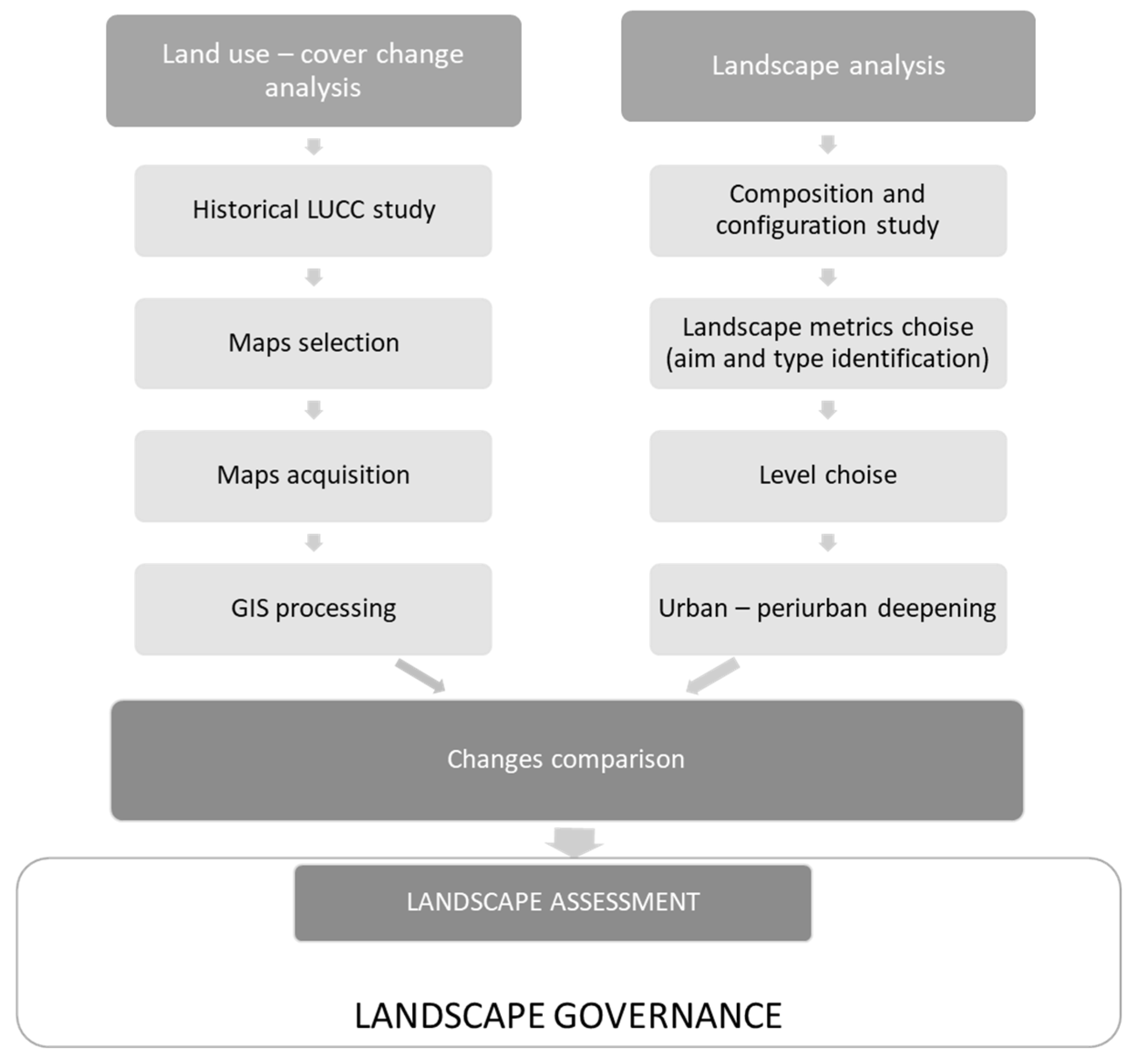
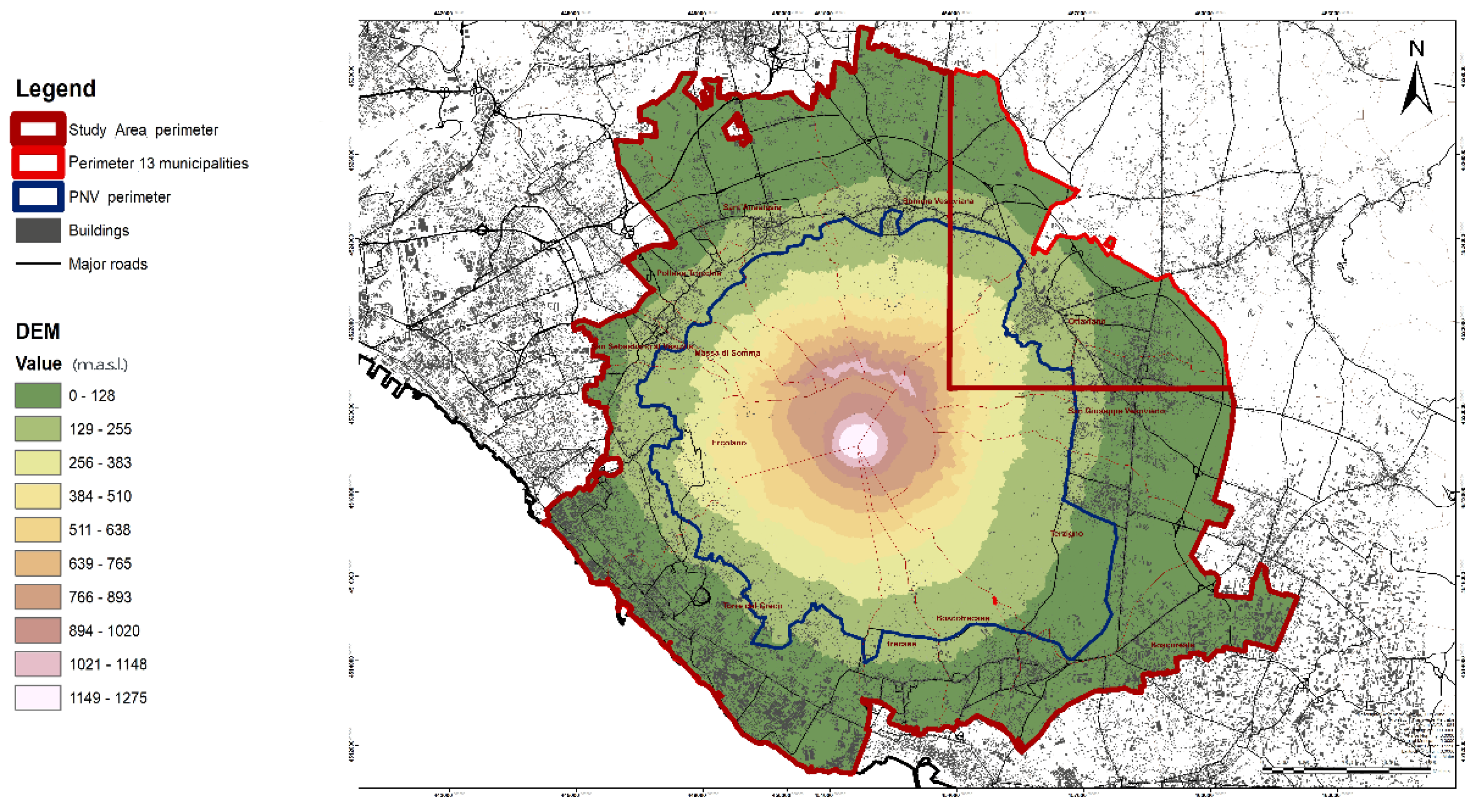
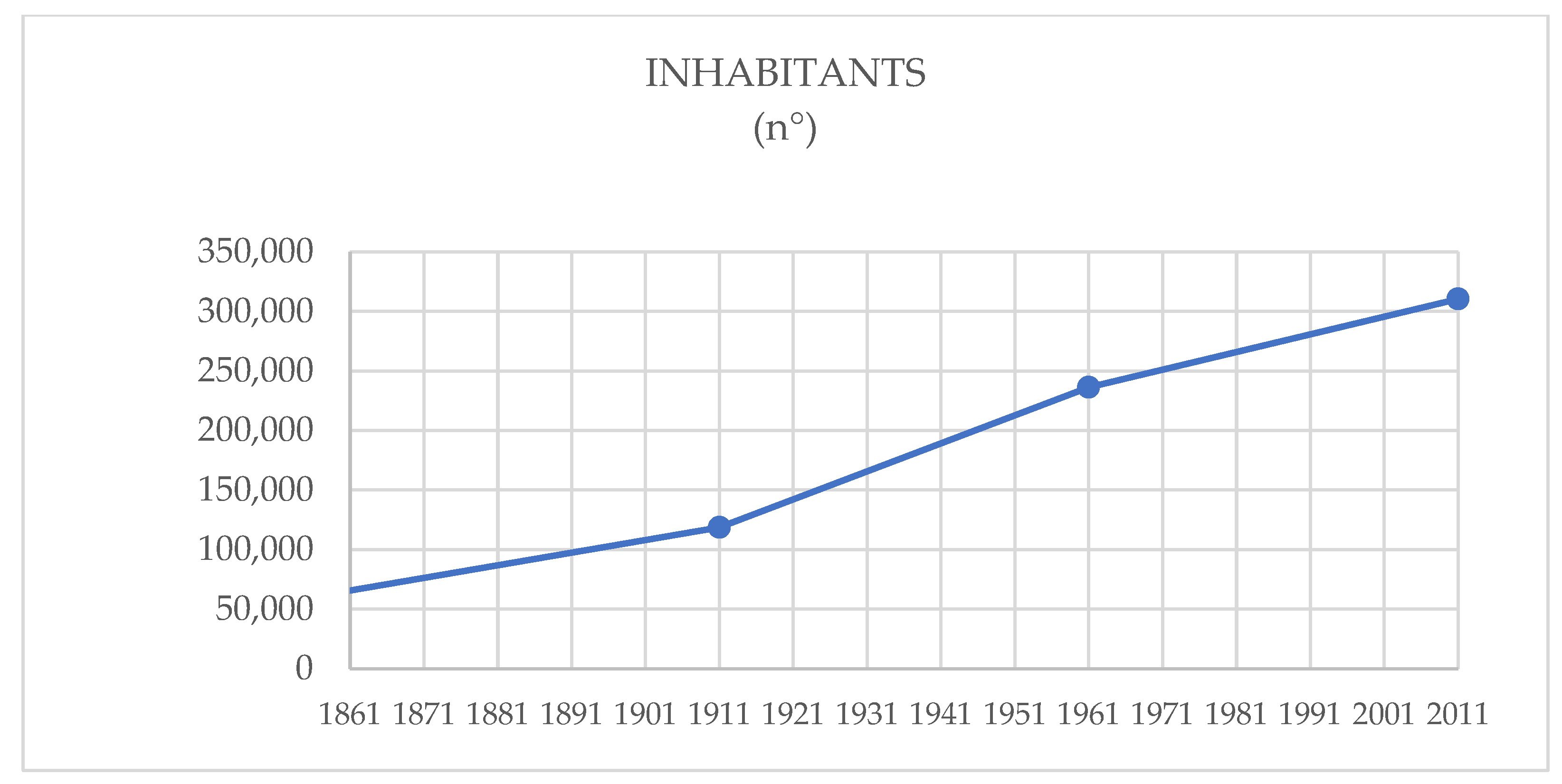
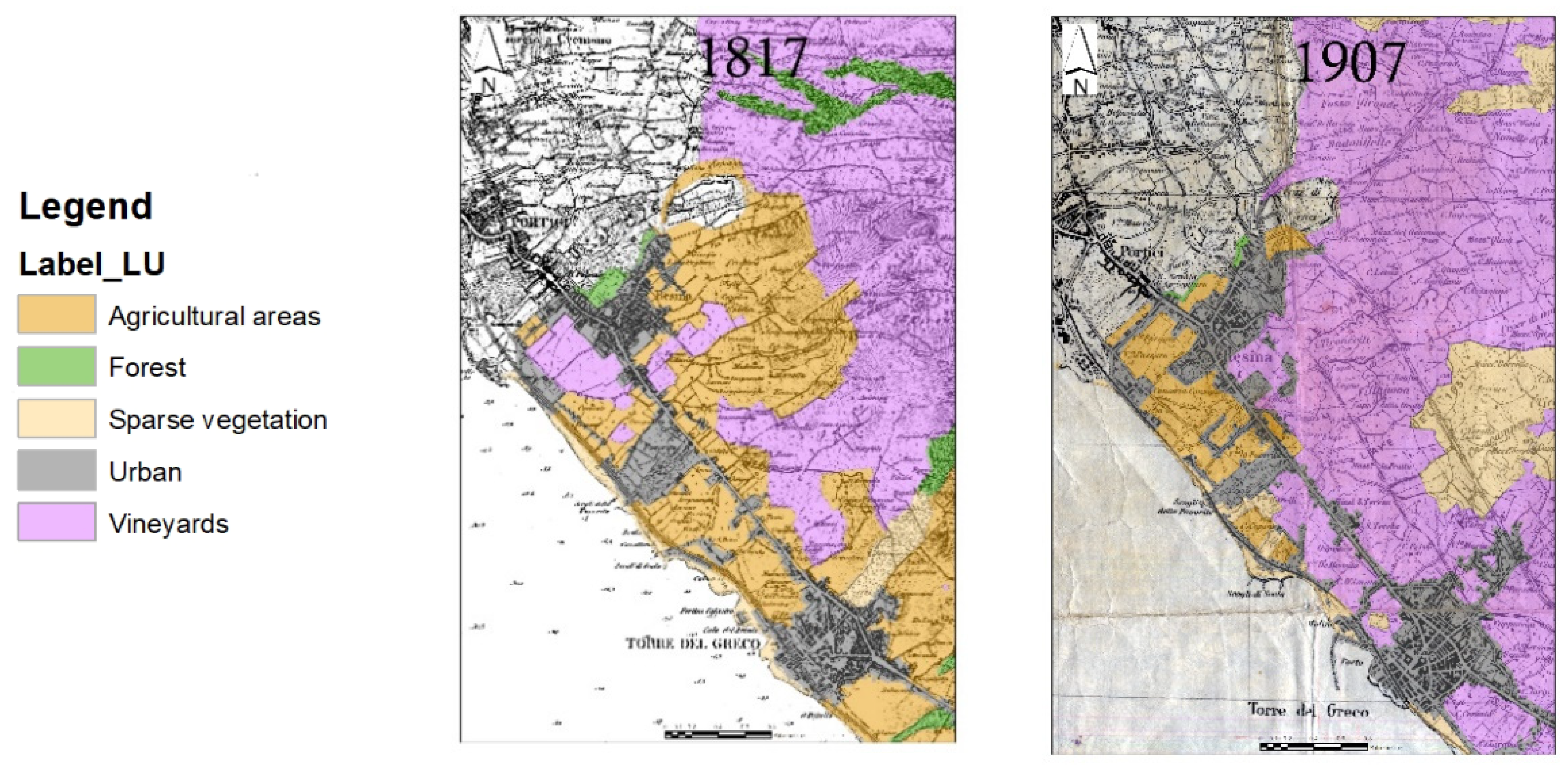
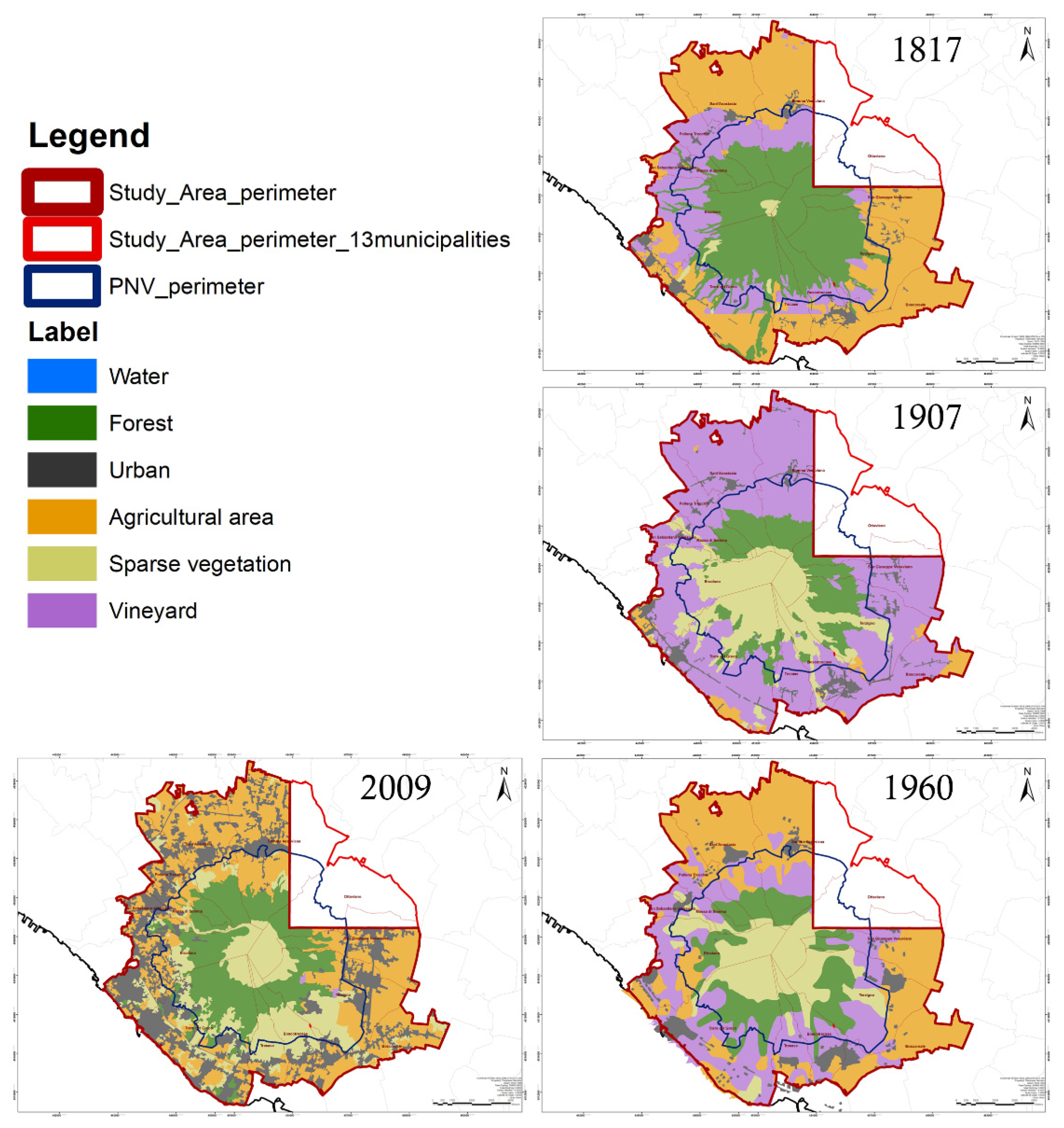


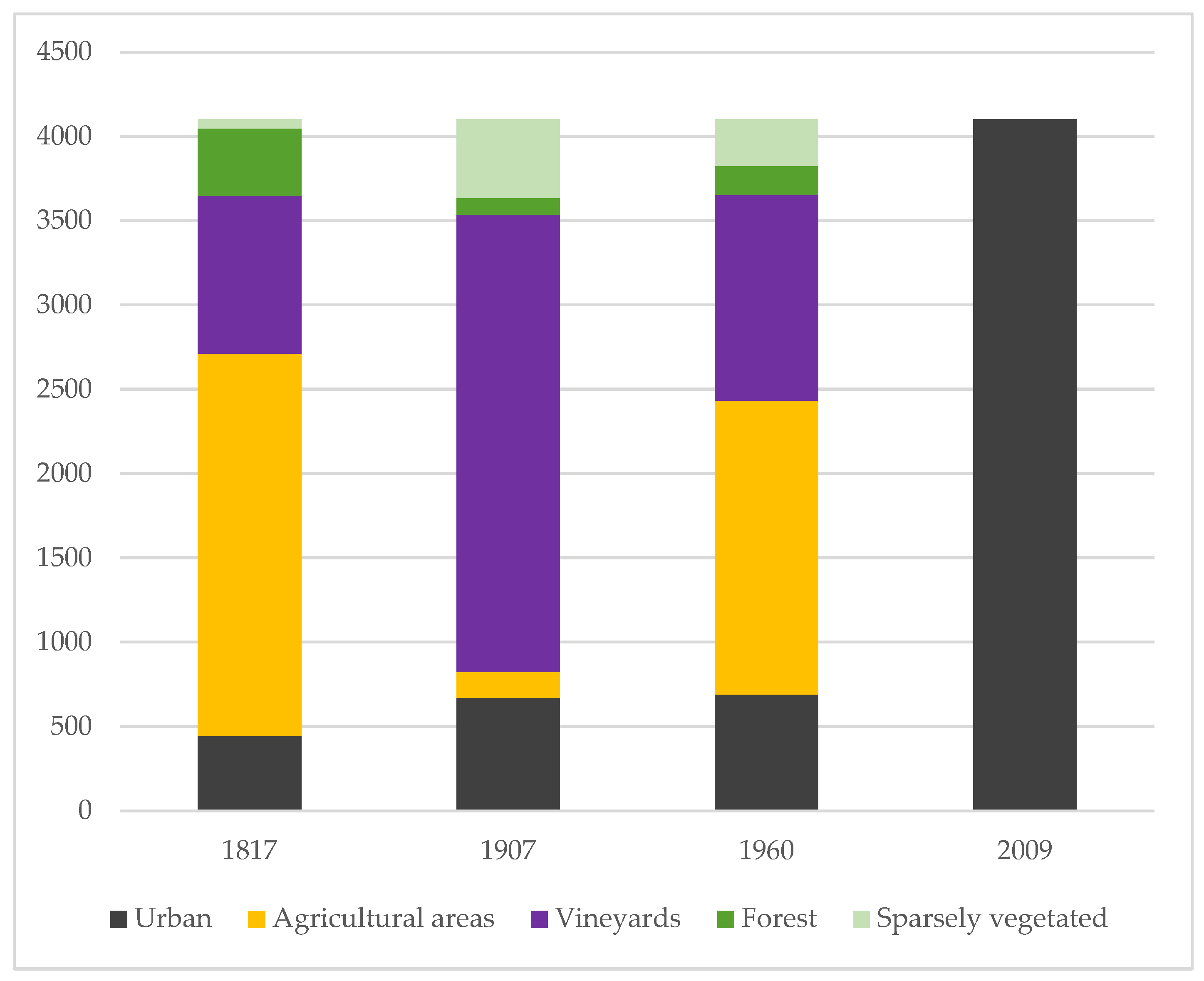
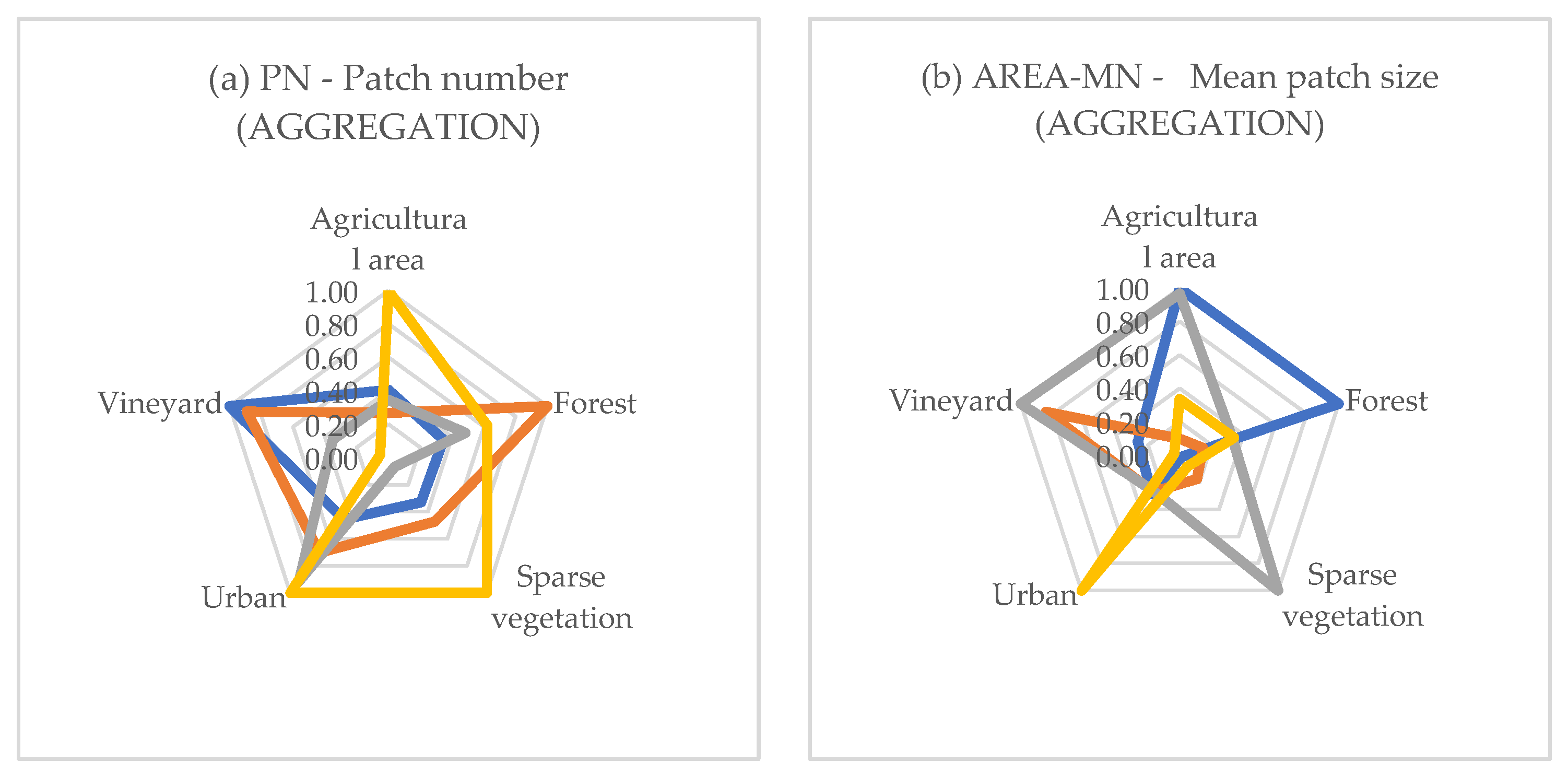
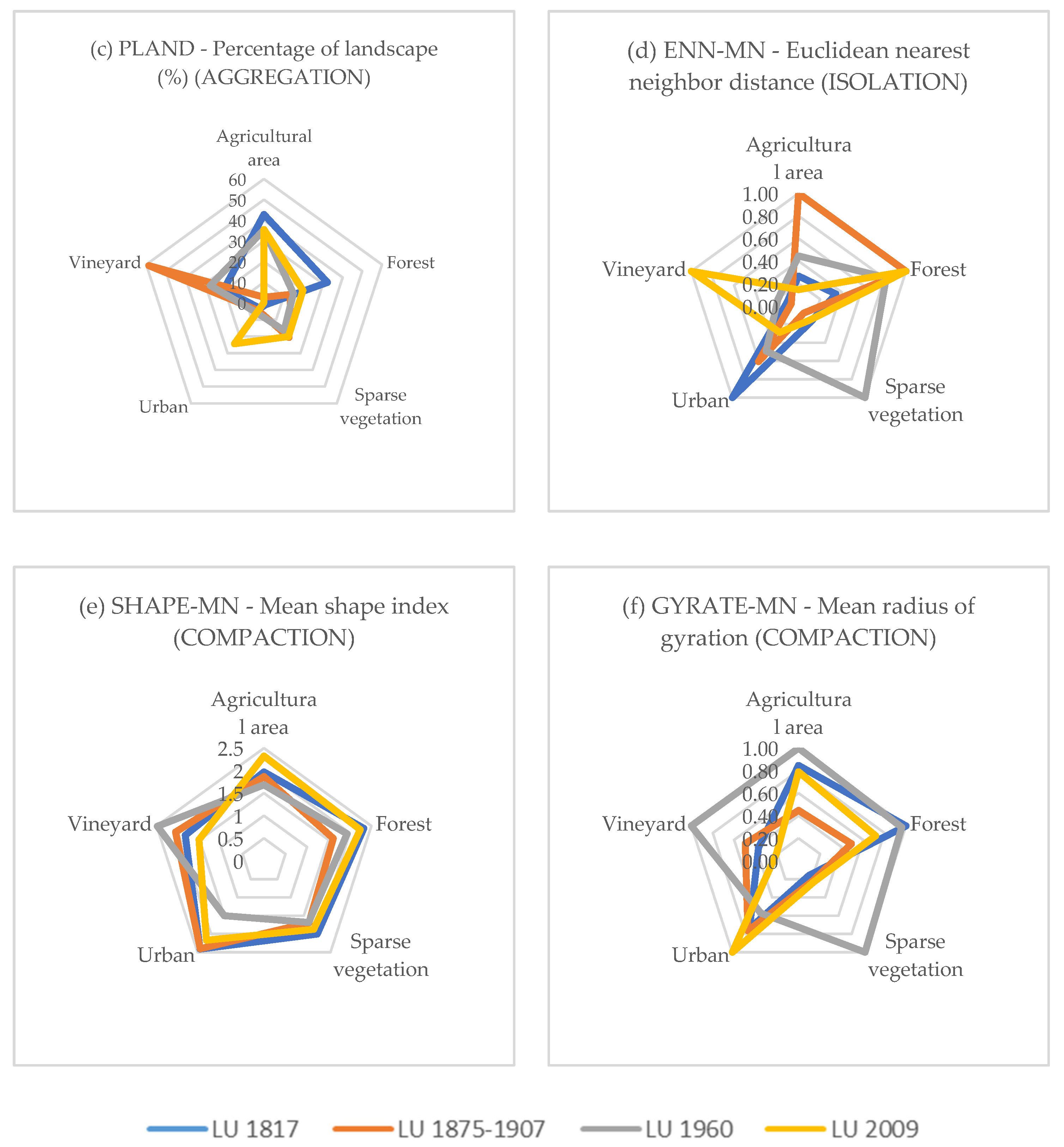


| Land-Use Label | Land Use Classes in the 2009 Map (Campania Region Agricultural Land Uses Map) |
|---|---|
| Urban | Urbanized environment and artificial surfaces |
| Agricultural areas | Protected crops (greenhouses); arable crops (autumn-winter arable crops, spring-summer arable crops, alternate fodder crops, other arable crops); permanent crops (orchards and minor fruits, fruit trees or shrubs plants, olive groves, citrus groves, fruit chestnut groves, poplar groves, willow groves, other broad-leaved trees, other permanent crops or fruit trees); permanent forage; heterogeneous agricultural areas |
| Vineyards | Vineyards |
| Forest | Deciduous woods; coniferous woods; mixed forests of conifers and deciduous trees |
| Sparse vegetation | Mainly shrubby and / or herbaceous vegetation cover in natural evolution (natural pasture areas and high altitude grasslands, bushes and shrubs, areas with sclerophyll vegetation, areas with arboreal and shrub vegetation in evolution, areas with natural recolonization, areas with artificial recolonization and reforestation); open areas with sparse or absent vegetation; beaches, dunes and sands, bare rocks and outcrops; areas with sparse vegetation; areas degraded by fires and other events |
| Water/Other | Waters; wetlands |
| Urban Growth Process | Metrics | ||
|---|---|---|---|
| Acronym | Formulae | Description | |
| Aggregation | NP | ni | NP ≥ 1 The number of patches is a simple measure of the extent of subdivision or fragmentation of the patch type. 1 = the landscape contains only one patch of the corresponding patch type, when the class consists of a single patch. |
| AREA_MN | Area ≥ 0 This is the mean of the patch size (AREA_MN) at the class level. A reduction in AREA at class level usually indicates increasing the fragmentation of a land use/cover class. | ||
| PLAND | 0 < PLAND ≤ 100 The percentage of the landscape quantifies the proportional abundance of each patch type in the landscape. 0 = all patches of habitat disappeared; 100 = one habitat occupies all the landscape. | ||
| Compaction | GYRATE_MN | GYRATE ≥ 0 GYRATE equals the mean distance between each cell in the patch and the patch type centroid. Radius of gyration is a measure of patch extent; thus, it is effected by both patch size and patch compaction and can be considered a measure of the average distance an organism can move within a patch before encountering the patch boundary from a random starting point. 0 = the patch consists of a single cell. The maximum values imply the patch comprises the entire landscape. | |
| SHAPE_MN | SHAPE ≥ 1 This shape index (SHAPE) measures the complexity of patch shape compared to a standard shape (square) of the same size and offers a fundamentally patch-centric perspective on the landscape structure. SHAPE equals patch perimeter (m) divided by the square root of patch area (m2), adjusted by a constant to adjust for a square standard. 1 = the patch is square and increases without limit as patch shape becomes more irregular | ||
| Dispersion | ENN_MN | hij | 0-Limitless This metric relates to the distance to the nearest patch of the same land use/cover class. ENN equals the distance (m) to the nearest neighbouring patch of the same type, based on shortest edge-to-edge distance. 0 = the distance to the nearest neighbour decreases. The upper limit is constrained by the extent of the landscape. |
| Label | 1817 % of the Total Area | 1907 % of the Total Area | 1960 % of the Total Area | 2009 s % of the Total Area |
|---|---|---|---|---|
| Urban | 3% | 5% | 6% | 24% |
| Agricultural areas | 43% | 3% | 36% | 36% |
| Vineyard | 21% | 59% | 27% | 0% |
| Forest | 32% | 13% | 15% | 20% |
| Sparse vegetation | 1% | 21% | 16% | 20% |
| TOTAL | 100% | 100% | 100% | 100% |
| Land Uses in 1817 inside the Urban Areas of the 1907 Map | Land Uses in 1907 inside the Urban Areas of the 1960 Map | Land Uses in 1960 inside the Urban Areas of the 2009 Map | ||||
|---|---|---|---|---|---|---|
| Label | ha | % | ha | % | ha | % |
| Urban | 358 | 46% | 401 | 42% | 693 | 17% |
| Agricultural uses | 331 | 43% | 29 | 3% | 1743 | 42% |
| Vineyards | 56 | 7% | 477 | 50% | 1222 | 30% |
| Forest | 10 | 1% | 2 | 0% | 169 | 4% |
| Sparse vegetation | 17 | 2% | 40 | 4% | 277 | 7% |
| TOTAL | 772 | 100% | 949 | 100% | 4104 | 100% |
| LU_1817\LU_2009 | 1—Urban | 2—Agricultural Uses | 3—Vineyard | 4—Forest | Sparse Vegetated | Sum LU_1817 |
|---|---|---|---|---|---|---|
| 1—Urban | 7067.4 | 935.5 | 0.0 | 158.2 | 326.2 | 8487.3 |
| 2—Agricultural uses | 36,290.1 | 67,409.9 | 0.0 | 789.9 | 11,028.4 | 115,518.2 |
| 3—Vineyard | 14,938.6 | 21,299.6 | 0.0 | 3768.4 | 15,567.4 | 55,573.9 |
| 4—Forest | 6386.2 | 6171.8 | 390.4 | 48,000.2 | 25,800.5 | 86,749.1 |
| 5—Sparse vegetated | 898.5 | 73.9 | 0.0 | 468.8 | 1415.6 | 2856.7 |
| Sum LU_2009 | 65,580.8 | 95,890.7 | 390.4 | 53,185.5 | 54,138.0 |
| LU_1817\LU_1907 | 1—Urban | 2—Agricultural Uses | 3—Vineyard | 4—Forest | 5—Sparse Vegetated | Sum LU_1817 |
|---|---|---|---|---|---|---|
| 1—Urban | 5724.5 | 343.2 | 2211.6 | 8.6 | 191.3 | 8479.2 |
| 2—Agricultural uses | 5277.7 | 5552.0 | 100,559.2 | 578.0 | 3539.4 | 115,506.2 |
| 3—Vineyard | 897.8 | 1024.5 | 42,826.9 | 2303.1 | 8504.8 | 55,557.0 |
| 4—Forest | 165.7 | 528.6 | 11,800.7 | 33,074.6 | 41,172.0 | 86,741.6 |
| 5—Sparse vegetated | 279.8 | 28.4 | 349.6 | 384.6 | 1930.1 | 2972.5 |
| Sum LU_1907 | 12,345.4 | 7476.7 | 157,748.0 | 36,348.9 | 55,337.6 |
| LU_1907\LU_1960 | 1—Urban | 2—Agricultural Uses | 3—Vineyard | 4—Forest | Sparse Vegetated | Sum LU_1907 |
|---|---|---|---|---|---|---|
| 1—Urban | 6384.7 | 3758.5 | 2031.6 | 33.9 | 151.7 | 12,360.4 |
| 2—Agricultural uses | 470.7 | 5358.0 | 1421.5 | 15.8 | 211.8 | 7477.8 |
| 3—Vineyard | 7547.6 | 83,295.4 | 57,263.6 | 5801.2 | 3857.6 | 157,765.4 |
| 4—Forest | 33.1 | 725.3 | 6276.0 | 21,928.1 | 7384.9 | 36,347.4 |
| 5—Sparse vegetated | 639.0 | 2562.1 | 6978.3 | 12,427.6 | 32,823.0 | 55,430.0 |
| Sum LU_1960 | 15,075.1 | 95,699.3 | 73,971.1 | 40,206.6 | 44,428.9 |
| LU_1960\LU_2009 | 1—Urban | 2—Agricultural Uses | 3—Vineyard | 4—Forest | 5—Sparse Vegetated | Sum LU_1960 |
|---|---|---|---|---|---|---|
| 1—Urban | 11,053.0 | 2831.7 | 0.0 | 86.7 | 1112.9 | 15,084.3 |
| 2—Agricultural uses | 27,890.1 | 59,665.6 | 0.0 | 970.2 | 7097.2 | 95,623.2 |
| 3—Vineyard | 19,551.4 | 27,261.6 | 0.2 | 6541.6 | 20,581.0 | 73,935.9 |
| 4—Forest | 2706.9 | 3521.2 | 184.2 | 25,634.7 | 8169.9 | 40,216.9 |
| 5—Sparse vegetated | 4427.8 | 2633.3 | 206.0 | 19,949.4 | 17,175.4 | 44,391.8 |
| Sum LU_2009 | 65,629.2 | 95,913.5 | 390.4 | 53,182.6 | 54,136.5 |
| LU_1817\LU_1907 | LU_1907\LU_1960 | LU_1960\LU_2009 | LU_1817\LU_2009 | |
|---|---|---|---|---|
| Kappa | 0.18408 | 0.30037 | 0.27414 | 0.30206 |
| KLocation | 0.65165 | 0.55157 | 0.41714 | 0.63008 |
| KHisto | 0.28248 | 0.54457 | 0.65719 | 0.4794 |
| Fraction correct | 0.33094 | 0.45941 | 0.42165 | 0.46025 |
| Land Uses | Hectares 1817 Map | Hectares 1960 Map |
|---|---|---|
| 1—Urban | 7067.44 | 11,053 |
| 2—Agricultural uses | 36,290.08 | 27,890.08 |
| 3—Vineyard | 14,938.6 | 19,551.44 |
| 4—Forest | 6386.16 | 2706.92 |
| 5—Sparse vegetated | 898.52 | 4427.76 |
| Sum Map | 65,637.96 | 65,637.96 |
| Code | Item 2018 | Area (ha) | % |
|---|---|---|---|
| 11210 | Discontinuous dense urban fabric (S.L.: 50–80%) | 1082.0 | 31.7% |
| 11220 | Discontinuous medium density urban fabric (S.L.: 30–50%) | 561.2 | 16.5% |
| 12100 | Industrial, commercial, public, military and private units | 360.5 | 10.6% |
| 11230 | Discontinuous low density urban fabric (S.L.: 10–30%) | 340.9 | 10.0% |
| 11100 | Continuous urban fabric (S.L.: >80%) | 298.3 | 8.8% |
| 12220 | Other roads and associated land | 254.6 | 7.5% |
| 13100 | Mineral extraction and dump sites | 85.2 | 2.5% |
| 23000 | Pastures | 78.8 | 2.3% |
| 21000 | Arable land (annual crops) | 60.5 | 1.8% |
| 32000 | Herbaceous vegetation associations (natural grassland, moors) | 45.3 | 1.3% |
| 14100 | Green urban areas | 42.6 | 1.3% |
| 14200 | Sports and leisure facilities | 40.5 | 1.2% |
| 12230 | Railways and associated land | 35.5 | 1.0% |
| 12210 | Fast transit roads and associated land | 34.7 | 1.0% |
| 31000 | Forests | 31.9 | 0.9% |
| 11240 | Discontinuous very low density urban fabric (S.L.: < 10%) | 25.0 | 0.7% |
| 13400 | Land without current use | 15.1 | 0.4% |
| 50000 | Water | 6.7 | 0.2% |
| 22000 | Permanent crops (vineyards, fruit trees, olive groves) | 5.4 | 0.2% |
| 11300 | Isolated structures | 2.8 | 0.1% |
| 13300 | Construction sites | 1.4 | 0.0% |
| TOTAL | 3408.8 | 100.0% |
Publisher’s Note: MDPI stays neutral with regard to jurisdictional claims in published maps and institutional affiliations. |
© 2022 by the authors. Licensee MDPI, Basel, Switzerland. This article is an open access article distributed under the terms and conditions of the Creative Commons Attribution (CC BY) license (https://creativecommons.org/licenses/by/4.0/).
Share and Cite
Cervelli, E.; Pindozzi, S. The Historical Transformation of Peri-Urban Land Use Patterns, via Landscape GIS-Based Analysis and Landscape Metrics, in the Vesuvius Area. Appl. Sci. 2022, 12, 2442. https://doi.org/10.3390/app12052442
Cervelli E, Pindozzi S. The Historical Transformation of Peri-Urban Land Use Patterns, via Landscape GIS-Based Analysis and Landscape Metrics, in the Vesuvius Area. Applied Sciences. 2022; 12(5):2442. https://doi.org/10.3390/app12052442
Chicago/Turabian StyleCervelli, Elena, and Stefania Pindozzi. 2022. "The Historical Transformation of Peri-Urban Land Use Patterns, via Landscape GIS-Based Analysis and Landscape Metrics, in the Vesuvius Area" Applied Sciences 12, no. 5: 2442. https://doi.org/10.3390/app12052442
APA StyleCervelli, E., & Pindozzi, S. (2022). The Historical Transformation of Peri-Urban Land Use Patterns, via Landscape GIS-Based Analysis and Landscape Metrics, in the Vesuvius Area. Applied Sciences, 12(5), 2442. https://doi.org/10.3390/app12052442







